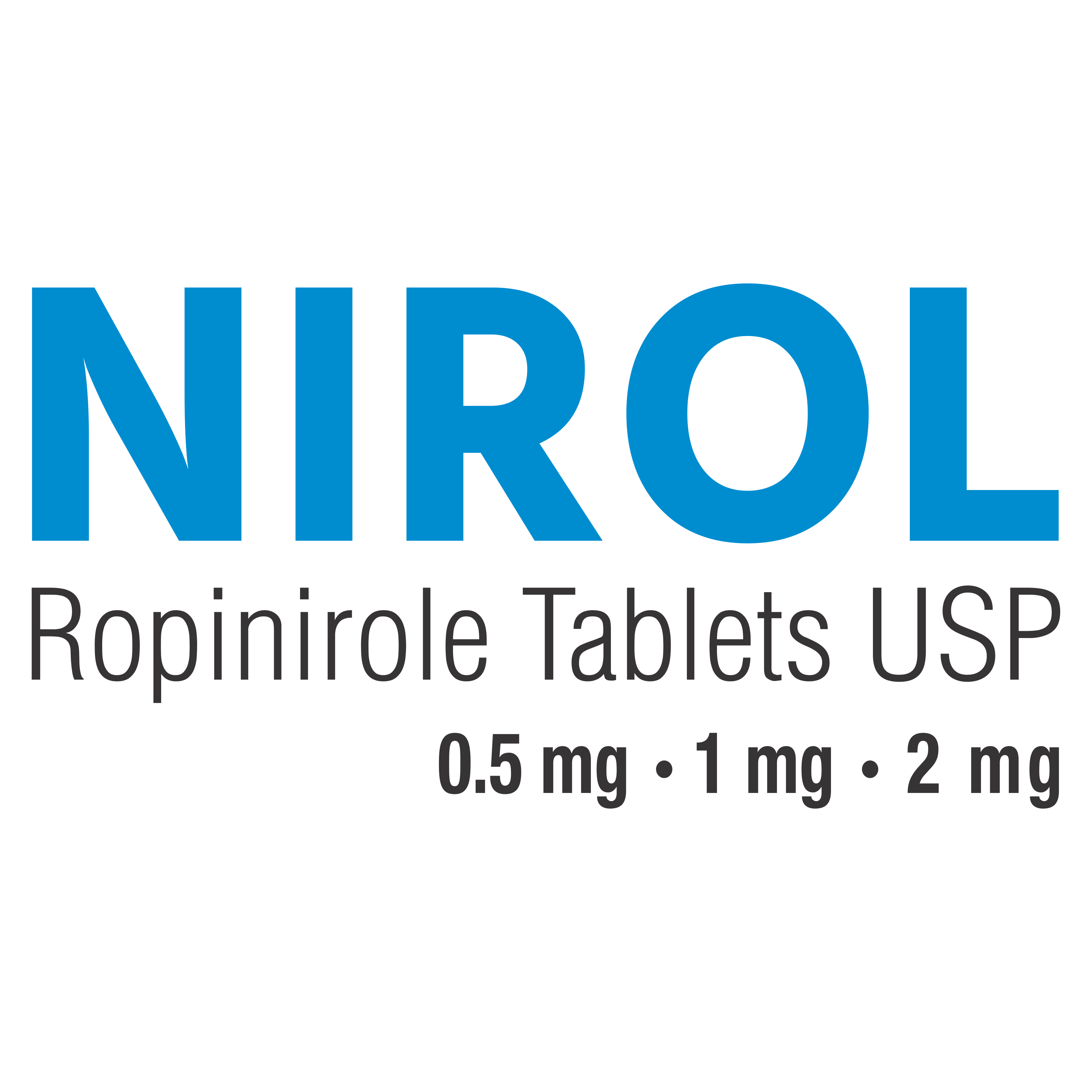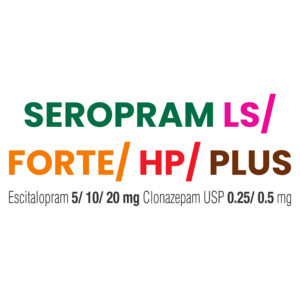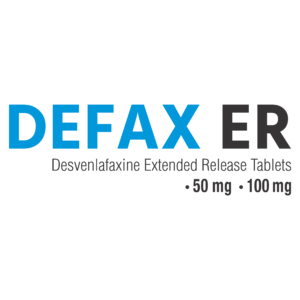NIROL
| Generic Name | Ropinirole Tablets USP |
| Strength | 0.5/1/2 mg |
| Dosage Form | Tablets |
Description
NIROL’s active substance is Ropinirole, which belongs to a group of medicines called dopamine agonists. Dopamine agonists affect the brain in a similar way to a natural substance called dopamine.
NIROL is used to treat Parkinson’s disease.
PATIENT INFORMATION LEAFLET
Read all of this leaflet carefully before you starts taking this medicine because it contains important information for you.
⦁ Keep this leaflet. You may need to read it again.
⦁ If you have any further questions, ask your doctor or pharmacist.
⦁ This medicine has been prescribed for you only. Do not pass it on to others. It may harm them, even if their signs of illness are the same as yours.
⦁ If you get any side effects talk to your doctor or pharmacist. This includes any possible side effects not listed in this leaflet.
What is in this leaflet
1. What NIROL is and what it is used for
2. What you need to know before you take NIROL
3. How to take NIROL
4. Possible side effects
5. How to store NIROL
6. Contents of the pack and other information
1. What NIROL is and what it is used for
The active substance in NIROL is Ropinirole, which belongs to a group of medicines called dopamine agonists. Dopamine agonists affect the brain in a similar way to a natural substance called dopamine.
NIROL is used to treat Parkinson’s disease.
People with Parkinson’s disease have low levels of dopamine in some parts of their brains. NIROL has effects similar to those of natural dopamine, so it helps to reduce the symptoms of Parkinson’s disease. NIROL is also used to treat the symptoms of moderate to severe idiopathic Restless Legs Syndrome. Moderate to severe Restless Legs Syndrome is typically represented by patients who have difficulty sleeping or severe discomfort in their legs or arms.
Restless Legs Syndrome is a condition characterised by an irresistible urge to move the legs and occasionally the arms, usually accompanied by uncomfortable sensations such as tingling, burning or prickling. These feelings occur during periods of rest or inactivity such as sitting or lying down, especially in bed, and are worse in the evening or at night.
Usually the only relief is obtained by walking about or moving the affected limbs, which often leads to problems sleeping. NIROL relieves the discomfort and reduces the urge to move the limbs that disrupts night time sleep.
2. What you need to know before you take NIROL
Do not take NIROL:
– if you are allergic to NIROL or any of the other ingredients of this medicine
– if you have a serious kidney disease – if you have liver disease.
Tell your doctor if you think any of these may apply to you.
Warnings and precautions
Talk to your doctor or pharmacist before taking NIROL. Medicines are not always suitable for everyone. Your doctor needs to know before you take NIROL if you suffer from or have suffered in the past from any of the following conditions:
⦁ you are pregnant or think you may be pregnant
⦁ you are breast feeding
⦁ you are under 18 years old
⦁ you have a serious heart complaint
⦁ you have a serious mental health problem.
Your doctor will then decide if NIROL is suitable for you, or whether you need extra check-ups while you are taking it.
Tell your doctor if you or your family/carer notices you are developing urges or cravings to behave in ways that are unusual for you or you cannot resist the impulse, drive or temptation to carry out certain activities that could harm yourself or others. These are called impulse control disorders and can include addictive gambling, excessive eating or spending, an abnormally high sex drive or a an increase in sexual thoughts or feelings. Your doctor may need to adjust or stop your dose.
While you are taking NIROL
Tell your doctor if you or your family notices that you are developing any unusual behaviors (such as an unusual urge to gamble or increased sexual urges and/or behaviors) while you are taking NIROL. Your doctor may need to adjust or stop your dose.
NIROL can make you feel drowsy. It can make people feel extremely sleepy, and it sometimes makes people fall asleep very suddenly without warning. This can occur most commonly with people with Parkinson’s disease. If you experience this, then do not drive or operate machinery.
After stopping or reducing NIROL
Tell your doctor if you experience symptoms such as depression, apathy (indifference), anxiety, fatigue, sweating or pain after stopping or reducing NIROL treatment (called dopamine agonist withdrawal syndrome or DAWS). If the problems persist more than a few weeks, your doctor may need to adjust your treatment.
Other medicines and NIROL
Tell your doctor or pharmacist if you are taking, have recently taken or might take any other medicines, including any herbal medicines or other medicines you obtained without a prescription. Remember to tell your doctor or pharmacist if you begin taking new medicine while you are taking NIROL.
Some medicines can affect the way NIROL works, or make it more likely that you will have side effects. NIROL can also affect the way some other medicines work.
These include:
⦁ the anti-depressant fluvoxamine
⦁ medication for other mental health problems, for example sulpiride
⦁ HRT (hormone replacement therapy)
⦁ metoclopramide, which is used to treat nausea and heartburn
⦁ the antibiotics ciprofloxacin or enoxacin
⦁ any other medicine for Parkinson’s disease or Restless Legs Syndrome.
Tell your doctor if you are taking, or have recently taken, any of these. You will require additional blood tests if you are taking these medicines with NIROL:
⦁ vitamin K antagonists (used to reduce blood clotting) such as warfarin.
Smoking and NIROL
Tell your doctor if you start smoking, or give up smoking, while you are taking NIROL. Your doctor may need to adjust your dose.
NIROL with food and drink
If you take NIROL with food, you may be less likely to feel sick (nauseous) or be sick (vomit). So it’s best to take it with food if you can.
Pregnancy and breast-feeding
NIROL is not recommended if you are pregnant, unless your doctor advises that the benefit to you of taking NIROL is greater than the risk to your unborn baby. NIROL is not recommended if you are breast feeding, as it can affect your milk production.
Tell your doctor immediately if you are pregnant, if you think you might be pregnant, or if you are planning to become pregnant. Your doctor will also advise you if you are breast feeding or planning to do so. Your doctor may advise you to stop taking NIROL.
Driving and using machines
NIROL can make you feel drowsy. It can make people feel extremely sleepy, and it sometimes makes people fall asleep very suddenly without warning. If you could be affected: do not drive, do not operate machines and do not put yourself in any situation where feeling sleepy or falling asleep could put you (or other people) at risk of serious injury or death. NIROL can cause hallucinations (seeing, hearing or feeling things that are not there). If affected, do not drive or use machines. Do not take part in these activities until you are no longer affected. Talk to your doctor if this causes problems for you.
NIROL contains lactose and sodium
If you have been told by your doctor that you have an intolerance to some sugars, contact your doctor before taking NIROL. This medicine contains less than 1 mmol sodium (23 mg) per tablet, that is to say essentially “sodium free”.
3. How to take NIROL
Always take this medicine exactly as your doctor or pharmacist has told you to. Check with your doctor or pharmacist if you are not sure.
You may be given NIROL on its own to treat the symptoms of your Parkinson’s disease or Restless Legs Syndrome. You may be given NIROL as well as another medicine called L-dopa (also called levodopa). Do not give NIROL to children. NIROL is not normally prescribed for people under 18. Swallow the NIROL tablet(s) whole with water. Do not chew or crush the tablet(s). The exact dose of NIROL people take can be different. Your doctor will decide on the dose you need to take each day and you should follow the doctors instructions. When you first start taking NIROL, the dose you take will be increased gradually.
How much NIROL will you need to take?
Parkinson’s disease
It may take a while to find out the best dose of NIROL for you.
The recommended starting dose is 0.25 mg of NIROL three times each day for the first week. Then your doctor will increase your dose each week, for the next three weeks. After that, your doctor will gradually increase the dose until you are taking the dose that is best for you. The recommended dose is 1 mg to 3 mg three times each day (making a total daily dose of 3 mg to 9 mg). If your Parkinson’s disease symptoms have not improved enough, your doctor may decide to gradually increase you dose some more. Some people take up to 8 mg of NIROL three times a day (24 mg daily altogether). If you are also taking other medicines for Parkinson’s disease, your doctor may advise you to gradually reduce the dose of the other medicine.
Restless Legs Syndrome
Take NIROL once a day by mouth, every day at the same time each day. NIROL is usually taken just before bedtime, but can be taken up to 3 hours before you go to bed. The starting dose is 0.25 mg once daily. After two days your doctor will probably increase you dose to 0.5 mg once daily for the remainder of your first week of treatment. Then your doctor may gradually increase your dose over the next three weeks to a dose of 2 mg per day.
If your symptoms have not improved, the dose may be increased gradually up to a maximum of 4 mg daily. After three months of treatment with NIROL, your doctor may adjust your dose or discontinue your treatment depending on your symptoms and how you feel. Do not take any more NIROL than your doctor has recommended. It may take a few weeks for NIROL to work for you.
If your symptoms get worse
Occasionally, people taking NIROL find that their Restless Legs Syndrome symptoms get worse. For example, symptoms may start earlier in the day, after a shorter time at rest, or the symptoms may affect other parts of the body, such as the arms. See your doctor if this happens to you.
Taking your dose of NIROL
Swallow your NIROL tablet(s) whole, with a glass of water. It is best to take NIROL with food, because that makes it less likely that you will feel sick (nauseous).
If you take more NIROL than you should
Contact a doctor or pharmacist immediately. If possible, show them the NIROL pack. Someone who has taken an overdose of NIROL may have any of these symptoms: feeling sick (nausea), being sick (vomiting), dizziness (a spinning sensation), feeling drowsy, mental or physical tiredness, fainting, seeing, feeling or hearing things that are not there (hallucinations).
If you forget to take NIROL
Do not take a double dose to make up for a forgotten dose. Just take your next dose at the usual time. If you have missed taking NIROL for one day or more, ask your doctor for advice on how to start taking it again.
Do not stop taking NIROL without advice
Take NIROL for as long as your doctor recommends. Do not stop unless your doctor advises you to. If you suddenly stop taking NIROL, your symptoms may quickly get much worse. A sudden stop could also cause you to develop a medical condition called neuroleptic malignant syndrome which may represent a major health risk. The symptoms include: akinesia (loss of muscle movement), rigid muscles, fever, unstable blood pressure, tachycardia (increased heart rate), confusion, depressed level of consciousness (e.g. Coma).
If you need to stop taking NIROL, your doctor will reduce your dose gradually.
If you have any further questions on the use of this medicine, ask your doctor or pharmacist.
4. Possible side effects
Like all medicines, this medicine can cause side effects, although not everybody gets them. The side effects of NIROL are more likely to happen when you first start taking it, or when your dose has just been increased. They are usually mild, and may become less troublesome after you have taken the dose for a while. If you’re worried about side effects, talk to your doctor. If you notice any of the following serious side effects, stop taking NIROL and contact a doctor immediately:
• swelling of the face, lips, mouth, tongue or throat which may cause difficulty in swallowing or breathing – not known (frequency cannot be estimated from the available data).
Other possible side effects:
Very common (may affect more than 1 in 10 people):
• fainting (sncope)
• feeling drowsy
• feeling sick or being sick
• uncontrollable movements (dyskinesia).
Common (may affect up to 1 in 10 people):
• hallucinations (‘seeing’ things that aren’t really there)
• feeling dizzy (a spinning sensation)
• heartburn
• abdominal pain
• swelling of the legs, feet or hands
• fatigue (mental or physical tiredness)
• nervousness
• worsening of RLS (symptoms may start earlier than usual or be more intense, or affect other previously unaffected limbs, such as the arms or return in the early morning).
Uncommon (may affect up to 1 in 100 people):
⦁ low blood pressure
⦁ feeling dizzy or faint, especially when you stand up suddenly (this is caused by a drop in blood pressure)
⦁ feeling very sleepy during the day (extreme somnolence)
⦁ falling asleep very suddenly without feeling sleepy first (sudden sleep onset episodes)
⦁ mental problems such as delirium (severe confusion), delusions (unreasonable ideas) or paranoia (unreasonable suspicions)
Not known (frequency cannot be estimated from the available data):
• changes in the liver function, which have shown up in blood tests
• allergic reactions such as red, itchy swellings on the skin (hives), rash or intense itching aggression
• craving for large doses of dopaminergic drugs in excess of that required to control motor symptoms, known as dopamine dysregulation syndrome
• after stopping or reducing NIROL treatment: depression, apathy (indifference), anxiety, fatigue, sweating or pain may occur (called dopamine agonist withdrawal syndrome or DAWS).
• inability to resist the impulse, drive or temptation to perform an action that could be harmful to you or others, which may include:
strong impulse to gamble excessively despite serious personal or family consequences. altered or increased sexual interest and behavior of significant concern to you or to others, for example, an increased sexual drive uncontrollable excessive shopping or spending binge eating (eating large amounts of food in a short time period) or compulsive eating (eating more food than normal and more than is needed to satisfy your hunger)
Tell your doctor if you experience any of these behavior; they will discuss ways of managing or reducing the symptoms.
If you’re taking NIROL with L-dopa
People who are taking NIROL with L-dopa may develop other side effects over time:
⦁ uncontrolled jerky movements are a very common side effect
⦁ feeling confused is a common side effect
Reporting of side effects
If you get any side effects talk to your doctor, or pharmacist. This includes any possible side effects not listed in this leaflet. By reporting side effects you can help provide more information on the safety of this medicine.
5. How to store NIROL
Keep this medicine out of the sight and reach of children.
Do not use this medicine after the expiry date which is stated on the label and outer carton after EXP. The expiry date refers to the last day of that month.
This medicine does not require any special storage conditions.
Do not throw away any medicines via wastewater or household waste. Ask your pharmacist how to throw away medicines you no longer use. These measures will help protect the environment.
6. Contents of the pack and other information
What NIROL contains
The active substance in NIROL is Ropinirole.
NIROL 0.5
Each film coated tablet contains:
Ropinirole Hydrochloride USP equivalent to Ropinirole 0.5 mg
Colours: Tartrazine Lake & Titanium Dioxide
NIROL 1
Each film coated tablet contains:
Ropinirole Hydrochloride USP equivalent to Ropinirole 1mg
Colours: Tartrazine Lake & Titanium Dioxide
NIROL 2
Each film coated tablet contains:
Ropinirole Hydrochloride USP equivalent to Ropinirole 2mg
Colours: Tartrazine Lake, Brilliant Blue Lake & Titanium Dioxide
What NIROL looks like and contents of the pack
NIROL 0.5 is Yellow, Round, biconvex, film coated tablets with break line on one side. NIROL 0.5 tablets are packed in a strip using printed polylaminated aluminium foil on one side and plain polylaminated aluminium foil on the other side. The pack size is 10 x 10 tablets in a printed paper carton with packing insert
NIROL 1 is Yellow, Round, biconvex, film coated tablets with break line on one side. NIROL 1 tablets are packed in a strip using printed polylaminated aluminium foil on one side and plain polylaminated aluminium foil on the other side. The pack size is 10 x 10 tablets in a printed paper carton with packing insert
NIROL 2 is Green, Round, biconvex, film coated tablets with break line on one side. NIROL 2 tablets are packed in a strip using printed polylaminated aluminium foil on one side and plain polylaminated aluminium foil on the other side. The pack size is 10 x 10 tablets in a printed paper carton with packing insert





